GAINING PERSPECTIVE
Among artists in different cultures of the ancient world, only the Greeks and Romans mastered the portrayal of spatial depth. Then, during the medieval period, understanding of this skill was lost in Europe. In the early 1400s, the Italian architect Filippo Brunelleschi (1377–1446) reintroduced a means of rendering the recession of space, called linear perspective. In Brunelleschi’s technique, lines appear to converge at a single fixed point in the distance. This produces a convincing depiction of spatial depth on a two-dimensional surface.Brunelleschi used this technique in a famous experiment. With the help of mirrors, he sketched the Baptistery in perfect perspective. He mathematically calculated the scale of objects to appear within a painting, in order to make them look realistic. This discovery of a mathematical system for representing three-dimensional objects and space on a two-dimensional surface was tremendously significant. Soon after Brunelleschi’s discovery, other artists employed this method of rendering perspective, with astonishing results.
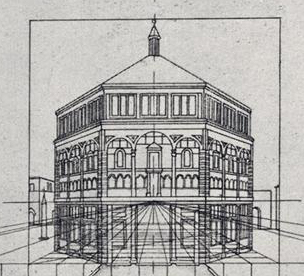
Diagram Demonstrating Filippo Brunelleschi's Perspective Technique from a Lost Painting of the Battistero di San Giovanni. Kunsthistorisches Institut in Florenz, Max-Planck-Institut. © 2006, SCALA, Florence / ART RESOURCE, N.Y.
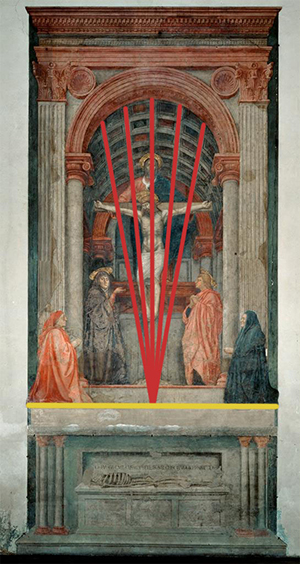
Perspective diagram of Masaccio (Italian, 1401–1428). The Holy Trinity. Fresco, 263 x 125 inches. S. Maria Novella, Florence, Italy. Erich Lessing/ART RESOURCE, N.Y.
The Italian sculptor Donatello’s Saint George and the Dragon completed in about 1417) is the first example of an artist’s use of linear perspective in relief sculpture. In addition to linear perspective, Donatello (Italian, about 1389–1466) suggested depth through optical qualities in the carving, which emphasize light and shadow. Together with its illusion of space, this work produces an illusion of real figures. This development points to the Renaissance idea of creating a picture window onto an entire world—an idea that Ghiberti brought to fruition in the Gates of Paradise
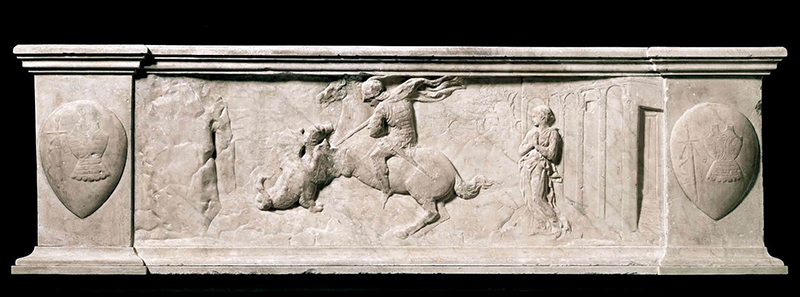
Donatello (Italian, ca. 1389–1466). Saint George and the Dragon, ca. 1414–1417. Marble, 15 23/64 x 47 1/4 inches. Photo Scala, Florence–courtesy of the Ministero Beni e Att. Culturali e del Turismo.
Ghiberti's approach to linear perspective and the depiction of figures in the Gates of Paradise was very different from that of his first commission for the Baptistery. In the earlier work, elements of a narrative are contained on a single ledge within a quatrefoil-a quintessentially medieval format. In contrast, the Gates of Paradise present figures nearly in the round. Some parts of their bodies extend out from the background, while others appear in shallow relief. Actions and developments within the narrative occupy the entire square format. With these compositional changes, Ghiberti moved away from medieval notions of space and storytelling to drama and action convincingly rendered in space-hallmarks of the Renaissance.
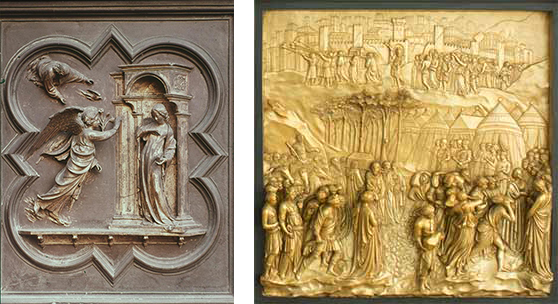
The Renaissance saw great advances in the depiction of form and perspective. Compare these two designs, both by Ghiberti. At left is a detail from his first commission for the north doors, 1404—1424. At right is a detail from his second commission, completed about 25 years later. Both images, Lorenzo Ghiberti (Italian, 1378—1455). LEFT: The Annunciation Panel, from the north doors, Florence Baptistery, 1404—1424. Gilt bronze. Image courtesy Opificio delle Pietre Dure, Florence. RIGHT: The Jacob and Esau Panel, from Gates of Paradise, 1425—1452. Gilt bronze. Collection of the Museo dell'Opera del Duomo. Image courtesy Opera di S. Maria del Fiore, Firenze.
Not only is Ghiberti's artistic genius reflected in his innovative use of perspective and his rendering of the three-dimensional form. He also considered the placement of a panel and planned the depth of carving accordingly, another of his innovations. Shallower reliefs appear in the bottom panels, with deeper reliefs at the top, adjustments that take into consideration the viewer's vantage point.
It is hard to overstate the importance of the Gates of Paradise. They serve as a touchstone of civic and religious life in Florence and mark a turning point in art history: the transition from the medieval era to the Renaissance.
European artists were not alone in their endeavor to depict perspective. By 1000 C.E., Chinese artists had invented atmospheric perspective. (Europeans, who had lost classical notions of receding space, had no method of rendering perspective at this time.) To achieve atmospheric perspective, Chinese artists used ink wash and blank silk to suggest depth, as seen in this landscape. Notice how the mountains fade into the background. European artists later developed a similar technique, using gradations of color from strong to pale to simulate depth of space through atmospheric change.

Xia Gui (Chinese, active 1180-1224). Twelve Views of Landscape (detail), Southern Song Dynasty (1127-1279). Handscroll, ink on silk, 10 3/4 x 99 7/8 in. Purchase: William Rockhill Nelson Trust, 32-159/2. Currently not on view.
Working at about the same time as Ghiberti, Persian artists were innovating yet another approach to perspective—the use of surface decoration to indicate depth. In this manuscript illustration, Abd Allah Musawwir used flattened compartments filled with dazzling patterns to suggest the receding interior of a religious school. The artist also illustrated groups of stylized figures in varying sizes, to denote their proximity to the viewer.
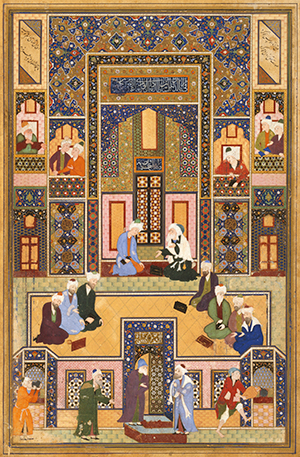
Abd Allah Musawwir (Persian, active mid-16th century). The Meeting of the Theologians, ca. 1540-1550. Opaque watercolor and gold on paper, 13 x 9 inches. Purchase: William Rockhill Nelson Trust, 43-5. Currently not on view.